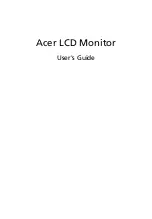
Industrial 19" CRT Monitor
7
Publication 6157-UM001A-EN-P
Following the guidelines below will help ensure that the monitor will
provide safe and reliable service.
•
Ensure that sufficient power is available from a single phase AC
outlet at the site.
•
Ensure that sufficient space is available around air inlets and outlets
to provide the circulation necessary for cooling. Never allow air
passages to become obstructed. The monitor is equipped with a fan
to ensure proper cooling.
•
Dust and smoke particles can cause problems, since they can collect
at ventilating holes in the enclosure and interfere with cooling.
Accordingly, where dust and smoke are problems it is especially
important to keep air vents clean. Refer to the Routine Maintenance
section (Page 39) for more information.
•
Ensure that the ambient air temperature will not exceed the
specified maximum temperature. A user supplied fan, heat exchanger,
or air conditioner may be required to meet this condition in some
installations.
•
Leave the monitor’s enclosure or cover in place at all times during
operation. The cover affords protection against high voltages inside
the monitor and inhibits radio-frequency emissions that might
interfere with other equipment.
•
The Federal Communications Commission has prepared a pamphlet
that addresses the problem of radio frequency interference to radio
and television reception, which should be consulted in case of
problems with such interference. This publication, “How to Identify
and Resolve Radio/TV Interference Problems” (Stock #004-000-
00345-4) may be obtained from the US. Government Printing Office,
Washington, DC 20402.
•
Determine the minimum and maximum ambient humidity for the
monitor by consulting the specification sheets at the back of this
manual. Ensure that the humidity of the ambient air will not exceed
these limits. In very dry environments, static charges build up very
readily. Proper grounding of the equipment through the AC power
cord can help reduce the likelihood of static discharges, which may
cause shocks and damage electronic components.








































